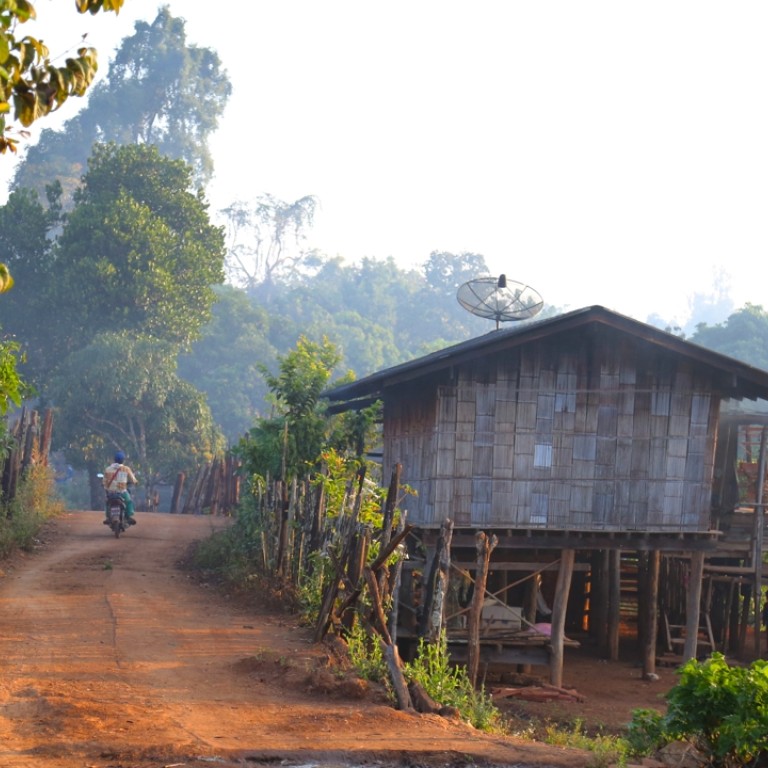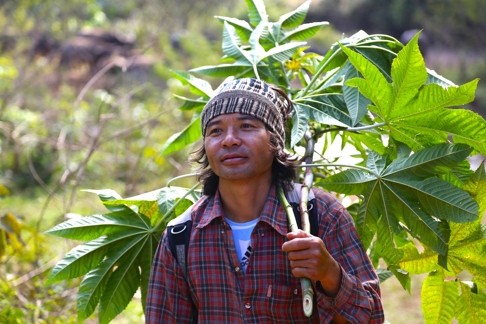
Remote trek in northern Thailand offers taste of a slower, simpler life
No Wi-fi, showers out of a saucepan: a three-day trek with homestays in the peaceful forests and hills of little visited region makes a welcome change from Thailand's overly commercialised hiking tours
There’s movement on the river bank, a crab making a dash for its hole. “They taste very good”, says Rang-sri Prasopturm, hiking guide and member of the Red Lahu, as we wade through the water. “I eat all the animals in the forest: crabs, cicadas, spiders, worms… And beer and whisky,” he jokes.
The occasional glass of whisky aside, these items aren’t on the menu for us, thankfully, during a new hill-tribes trek in northern Thailand, not far from the border with Myanmar (Burma).
The three-day expedition is a chance to see how local people live in the remote hills and forests of this little visited region – a rural way of life that’s close to nature. Homestays in small farming villages along the route are basic; we sleep on mattresses on the floors of wooden houses. There’s no Wi-fi, a welcome break from the modern world. Showers involve pouring cold water over yourself with a saucepan. The new trek and homestays have been created, in part, to help bring money and development to these rural communities.
Before starting the trek I spent time in Chiang Mai, the “capital of the north”, staying at 137 Pillars House, a quiet boutique hotel whose creature comforts are a world apart from the simple life I’ll experience in the hills. Chiang Mai is a far mellower city than Bangkok. There are busy, frenetic streets filled with traffic, but there are also peaceful golden temples where monks in saffron robes stroll around and the air’s filled with incense. I spend a day exploring the numerous temples inside the Old Town, checking out golden statues of Buddha and carvings of serpents and dragons.

I team up with my trekking group and we drive out of Chiang Mai, the road twisting and winding (we were warned of “2,000 bends”) as we climb higher into lush, green hills. Most so-called hill-tribe treks start around two hours outside Chiang Mai, but these easy-to-access areas have grown popular over the last 20-30 years, with some trails reported to be overrun with travellers and overly commercialised, with local hawkers putting the hard sell on hikers to buy handmade crafts and jewellery. We travelled further afield, driving four-and-a-half hours northwest from Chiang Mai to start our trek at the roadside Pa Mai Deang (Red Wood Forest) trailhead in Mae Hong Son province.


Rang-sri points to plants used by local people who know the forest: a tree’s bark is stripped and tightly twisted into a thread to make rope; another plant’s leaves are used to treat wounds. Through gaps in the trees, I see limestone peaks looming above us.
After lunch in a bamboo shelter prepared by local women from the Red Lahu tribe (rice, fried cabbage and egg, grilled snakehead fish), we complete a few short climbs, hot work in the afternoon sun, before making our way across a green valley and up to the village of Pha Mon.
Around 72 families live in Pha Mon, many of them farmers. Roosters, pigs and dogs amble through the streets, but the village is more developed than I expected, with motorbikes and trucks parked outside large wooden and concrete houses. I spot satellite dishes around the village. Many villagers own smartphones or iPads. This isn’t the picture of traditional ‘tribal’ life travellers might expect on a “hill-tribes trek”; local people wear jeans, T-shirts and sweatshirts, rather than traditional costumes, ornate jewellery or make-up and tattoos. What we’re getting instead is a slice of quiet, rural life.

Yajoe shows two hikers and I into his home. “I like to live here,” Yajoe says (with Ball translating), as we settle down to dinner, with daylight fading over the cornfields. “I feel free here. I go where I want to go. I feel safe and comfortable. We have little money, but it’s good here.”
Villagers hope the community’s tourism project can help bring money into the area, which was previously dominated by opium production. “Many villages in the past developed in this way, the ‘black business’,” Yajoe explains. “Now, we can grow anything: rice, corn… It’s better money. And we feel less scared of soldiers coming because opium was illegal.”
I wake to a chorus of roosters. Smoke from kitchen fires drifts through the village as we set off through a wide valley and up steep forest trails on our way from Pha Mon to the White Karen village of Muang Pam. Rang-sri sings and whistles as we follow a river, stepping in and out of the shallow water. Large spiders hang in webs across tree branches.

In the afternoon, we pass buffaloes lazing by a river, then climb a ladder to a cave where Rang-sri shows us the Saedi pagoda (shrine). “This is 600 years old, maybe built by the Chan people,” he says.
Rang-sri breaks off a leafy branch from an aubergine tree and, further along, dips the branch into a river teeming with big dark Soro Brooke carp. The water thrashes, a frenzy of fish heads and tails. Seconds later, the branch is bare, stripped by the fish.
Muang Pam village is larger than Pha Mon, with a population of 600. In the evening, a small group of us relax by the kitchen fire in Rang-sri’s home, occasionally joined by a lively puppy and bold chickens scavenging for scraps. Dinner includes a bowl of ferns and tasty mushrooms that Rang-sri picked from the forest during our hike. Whisky’s passed around to everyone, except Yajoe, whose wife, he explains, can communicate with spirits (villagers call themselves Buddhist, but believe in spirits and other elements of Animism) who’ve told her that she’ll become ill if her husband drinks. He hasn’t touched a drop in three years.

“The life here is simple and easy,” says Rang-sri, as we eat. “If I lived in the city, people have too many things to do every day,” he said, explaining the appeal of village life. “They rush, they never go slow, like in this the village. The simple life is better.”
Rang-sri points to the TV across the room, the first TV that came into the village. Other changes have come to the village. “We’ve lost some of our skills. Some old people can still weave a basket, but young people might just buy a plastic basket. Life is more convenient. People buy what they need from the city. But the way of living is the same.”
Our group hikes out of the village to spend the morning crossing a winding river, up to our knees in cool water. “This is the Lang river,” Rang-sri tells me. “It comes in here from Myanmar. The border is just 20km away.”

We cut through small farms, coming out at a spot on the river where teenage boys are throwing nets to catch small fish. Our van’s waiting here at the trek’s end to carry us to nearby Tham Nam Lod Wildlife & Nature Education Centre, a vast cave system containing columns, stalactites, stalagmites and a rock formation shaped like a crocodile.
It’s our final stop before our group loads up into the van to return to Chiang Mai. We start the journey back along the 2,000 bends, dropping off Rang-sri and Yajoe, who quickly disappear into the peaceful, green and food-filled forest.
Getting there
Graeme Green travelled with G Adventures (gadventures.co.uk), whose new, five-day Northern Thailand Hilltribes Trek costs from HK$2,600 per person, including two nights at a hotel in Chiang Mai with breakfast, all meals during the trek, van transport and guides.
Staying there
In Chiang Mai, the author stayed at 137 Pillars House hotel (137pillarshouse.com), which costs from 12,700 Thai baht (HK$2,800) per night, including breakfast, soft drinks and beer from the mini bar.
Thai Airways (thaiairways.com, (852) 2179 7777) has return flights from Hong Kong to Chiang Mai via Bangkok, starting from HK$ 3,145.
For more on Thailand, visit: tourismthailand.org
